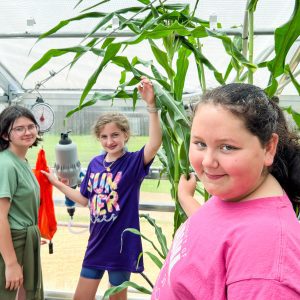Home & Family

AUBURN UNIVERSITY, Ala. — For the second straight year, students at Guin Elementary attended a fun and engaging food demonstration hosted by an Alabama Cooperative Extension System regional agent. However, this year part of the food used in the demo was grown on the school’s campus.
Ginger Eatman, Alabama Extension Supplemental Nutrition Assistance Program-Education (SNAP-Ed) regional agent for Walker and Marion counties, hosted nine food demos across Walker and Marion counties. The demo was a reward for third graders who completed Body Quest, an innovative childhood obesity prevention initiative that empowers third graders and their parents to make healthier choices.
Greenhouse Effect
Teachers, principals and students were called to participate in the demos featuring Live Well Alabama recipes, but Guin Elementary students had the special pleasure of preparing meals with the produce they watched sprout from the ground.
Guin Elementary is home to the first of four greenhouses to be constructed in Marion County. The structures are funded through the Marion County Board of Education with Elementary and Secondary School Emergency Relief Funds (ESSER). Each greenhouse will be built with the funds, including the one in Guin. Other greenhouses will be constructed at Hamilton Elementary, Hackleburg Elementary and Brilliant Elementary.
Beyond voicing her support for the greenhouses, Eatman partnered with the Northwest RC&D to provide spinach seeds, cups and soil for the greenhouse. She also partnered with Jayne Luetzow, Alabama Extension Homegrounds regional agent, and local Master Gardeners to plant seeds with all grades in the greenhouse this past spring. Most recently, students planted bell peppers seeds to use for food demos at the end of the school year.
Guin Elementary Principal Josh Weatherly said the greenhouse helps students have a sense of ownership over the produce grown.
“I think watching things grow builds excitement for learning,” he said. “When they plant it, they see the whole process and they enjoy watching it happen. They are more likely to try something that they have helped grow.”
Farm To Table
The featured recipe in the food demo for Guin Elementary was Hearty Egg Burritos. In the greenhouse, students planted bell peppers seeds, harvested them and enjoyed the vegetable as a side to the burritos. Additionally, students learned how to harvest other crops and weigh the produce.
The goal is to increase the variety of seedlings in greenhouses throughout Marion and Walker counties. In Walker County, Eatman said the district has a cooking class in the summer which would be a good opportunity to utilize the produce grown. She’s also working on getting involved in a life skills class to teach students about cooking a healthy meal. Her goal is for schools to use greenhouse-grown food for snacks and tastings, expanding students’ vegetable exposure.
“If they grow it, they are more apt to eat it,” she said.
Partnership
Weatherly said beyond teaching kids healthier eating habits, Eatman teaches kids about the importance of getting out and moving around.
“She always does whatever it takes to get the students excited,” he said. “Many times, she will come in with crazy outfits or whatever to draw the kids in. She is an amazing educator.”
Outside of the classroom, Weatherly said Eatman has been vital to helping the school secure funding to keep projects going. Guin Elementary has purchased garden tools, seeds and soil thanks to Eatman’s community partnerships.
“She makes our school a better place not only for kids but for our staff as well,” Weatherly said.
Future Goals
Eatman said the demo was meant to show students how easy the recipes can be made in hopes that they’ll tell their parents they want to make it at home. She said the idea stemmed from classroom experiences.
During the Body Quest curriculum, she asks how often students make the recipes discussed in the classroom at home. She felt she needed to do something to reinforce education in the classroom by creating an exciting tasting experience for the students and teaching them ways to consume more fruits and vegetables.
The endgame is to implement Live Well Alabama recipes into the school menu in the district. Moreover, Eatman would like to see the produce grown in the greenhouse as part of the school menu using the recipes. She is working with the Alabama Department of Education Child Nutrition Programs to include the recipes in lunchrooms.
“I hear from parents all the time that their children are asking for these recipes at home,” Eatman said. “Anything we can do to teach kids to how to create a healthy plate would be a win.”
More Information
For more information, contact Eatman at gne0001@aces.edu. For success stories about SNAP-Ed REAs or SNAP-Ed Educators, visit www.livewellalabama.com or visit Live Well Alabama on Facebook, Twitter and Instagram.










